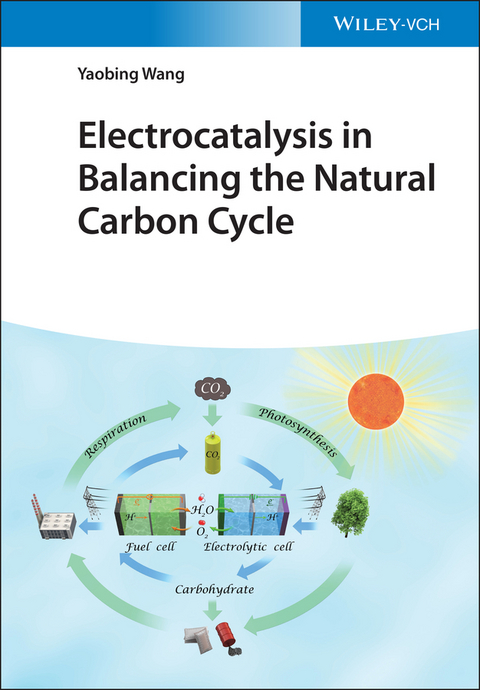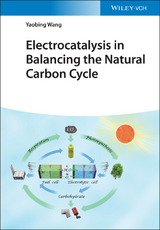Electrocatalysis in Balancing the Natural Carbon Cycle
Wiley-VCH (Verlag)
978-3-527-34913-5 (ISBN)
Yaobing Wang is now Professor at Fujian Institute of Research on the Structure of Matter, Chinese Academy of Sciences. He received his Ph.D. degree from Institute of Chemistry, Chinese Academy of Sciences in 2008. His research is focused on design and synthesis of novel electrocatalysts and their applications in energy conversion and storage, etc.
Preface
Acknowledgments
Part I Introduction
1 Introduction
Reference
Part II Natural Carbon Cycle
2 Natural Carbon Cycle and Anthropogenic Carbon Cycle
2.1 Definition and General Process
2.2 From Inorganic Carbon to Organic Carbon
2.3 From Organic Carbon to Inorganic Carbon
2.4 Anthropogenic Carbon Cycle
2.4.1 Anthropogenic Carbon Emissions
2.4.2 Capture and Recycle of CO2 from the Atmosphere
2.4.3 Fixation and Conversion of CO2
2.4.3.1 Photochemical Reduction
2.4.3.2 Electrochemical Reduction
2.4.3.3 Chemical/Thermo Reforming
2.4.3.4 Physical Fixation
2.4.3.5 Anthropogenic Carbon Conversion and Emissions Via Electrochemistry
References
Part III Electrochemical Catalysis Process
3 Electrochemical Catalysis Processes
3.1 Water Splitting
3.1.1 Reaction Mechanism
3.1.1.1 Mechanism of OER
3.1.1.2 Mechanism of ORR
3.1.1.3 Mechanism of HER
3.1.2 General Parameters to Evaluate Water Splitting
3.1.2.1 Tafel Slope
3.1.2.2 TOF
3.1.2.3 Onset/Overpotential
3.1.2.4 Stability
3.1.2.5 Electrolyte
3.2 Electrochemistry CO2 Reduction Reaction (ECDRR)
3.2.1 Possible Reaction Pathways of ECDRR
3.2.1.1 Formation of HCOO- or HCOOH
3.2.1.2 Formation of CO
3.2.1.3 Formation of C1 Products
3.2.1.4 Formation of C2 Products
3.2.1.5 Formation of CH3COOH and CH3COO-
3.2.1.6 Formation of n-Propanol (C3 Product)
3.2.2 General Parameters to Evaluate ECDRR
3.2.2.1 Onset Potential
3.2.2.2 Faradaic Efficiency
3.2.2.3 Partial Current Density
3.2.2.4 Environmental Impact and Cost
3.2.2.5 Electrolytes
3.2.2.6 Electrochemical Cells
3.3 Small Organic Molecules Oxidation
3.3.1 The Mechanism of Electrochemistry HCOOH Oxidation
3.3.2 The Mechanism of Electro-oxidation of Alcohol
References
Part IV Water Splitting and Devices
4 Water Splitting Basic Parameter/Others
4.1 Composition and Exact Reactions in Different pH Solution
4.2 Evaluation of the Catalytic Activity
4.2.1 Overpotential
4.2.2 Tafel Slope
4.2.3 Stability
4.2.4 Faradaic Efficiency
4.2.5 Turnover Frequency
References
5 H2O Oxidation
5.1 Regular H2O Oxidation
5.1.1 Noble Metal Catalysts
5.1.2 Other Transition Metals
5.1.3 Other Catalysts
5.2 Photo-Assisted H2O Oxidation
5.2.1 Metal Compound-Based Catalysts
5.2.2 Metal-Metal Heterostructure Catalysts
5.2.3 Metal-Nonmetal Heterostructure Catalysts
References
6 H2O Reduction and Water Splitting Electrocatalytic Cell
6.1 Noble-Metal-Based HER Catalysts
6.2 Non-Noble Metal Catalysts
6.3 Water Splitting Electrocatalytic Cell
References
Part V H2 Oxidation/O2 Reduction and Device
7 Introduction
7.1 Electrocatalytic Reaction Parameters
7.1.1 Electrochemically Active Surface Area (ECSA)
7.1.1.1 Test Methods
7.1.2 Determination Based on the Surface Redox Reaction
7.1.3 Determination by Electric Double-Layer Capacitance Method
7.1.4 Kinetic and Exchange Current Density (jk and j0)
7.1.4.1 Definition
7.1.4.2 Calculation
7.1.5 Overpotential HUPD
7.1.6 Tafel Slope
7.1.7 Halfwave Potentials
References
8 Hydrogen Oxidation Reaction (HOR)
8.1 Mechanism for HOR
8.1.1 Hydrogen Bonding Energy (HBE)
8.1.2 Underpotential Deposition (UPD) of Hydrogen
8.2 Catalysts for HOR
8.2.1 Pt-based Materials
8.2.2 Pd-Based Materials
8.2.3 Ir-Based Materials
8.2.4 Rh-Based Materials
8.2.5 Ru-Based Materials
8.2.6 Non-noble Metal Materials
References
9 Oxygen Reduction Reaction (ORR)
9.1 Mechanism for ORR
9.1.1 Battery System and Damaged Electrodes
9.1.2 Intermediate Species
9.2 Catalysts in ORR
9.2.1 Noble Metal Materials
9.2.1.1 Platinum/Carbon Catalyst
9.2.1.2 Pd and Pt
9.2.2 Transition Metal Catalysts
9.2.3 Metal-Free Catalysts
9.3 Hydrogen Peroxide Synthesis
9.3.1 Catalysts Advances
9.3.1.1 Pure Metals
9.3.1.2 Metal Alloys
9.3.1.3 Carbon Materials
9.3.1.4 Electrodes and Reaction Cells
References
10 Fuel Cell and Metal-Air Battery
10.1 H2 Fuel Cell
10.2 Metal-Air Battery
10.2.1 Metal-Air Battery Structure
References
Part VI Small Organic Molecules Oxidation and Device
11 Introduction
11.1 Primary Measurement Methods and Parameters
11.1.1 Primary Measurement Methods
11.1.2 Primary Parameter
References
12 C1 Molecule Oxidation
12.1 Methane Oxidation
12.1.1 Reaction Mechanism
12.1.1.1 Solid-Liquid-Gas Reaction System
12.1.2 Acidic Media
12.1.3 Alkaline or Neutral Media
12.2 Methanol Oxidation
12.2.1 Reaction Thermodynamics and Mechanism
12.2.2 Catalyst Advances
12.2.2.1 Pd-Based Catalysts
12.2.2.2 Pt-Based Catalysts
12.2.2.3 Platinum-Based Nanowires
12.2.2.4 Platinum-Based Nanotubes
12.2.2.5 Platinum-Based Nanoflowers
12.2.2.6 Platinum-Based Nanorods
12.2.2.7 Platinum-Based Nanocubes
12.2.3 Pt-Ru System
12.2.4 Pt-Sn Catalysts
12.3 Formic Acid Oxidation
12.3.1 Reaction Mechanism
12.3.2 Catalyst Advances
12.3.2.1 Pd-Based Catalysts
12.3.2.2 Pt-Based Catalysts
References
13 C2+ Molecule Oxidation
13.1 Ethanol Oxidation
13.1.1 Reaction Mechanism
3.1.2 Catalyst Advances
13.1.2.1 Pd-Based Catalysts
13.1.2.2 Pt-Based Catalysts
13.1.2.3 Pt-Sn System
13.2 Glucose Oxidase
13.3 Ethylene Glycol Oxidation
13.4 Glycerol Oxidation
References
14 Fuel Cell Devices
14.1 Introduction
14.2 Types of Direct Liquid Fuel Cells
14.2.1 Acid and Alkaline Fuel Cells
14.2.2 Direct Methanol Fuel Cells (DMFCs)
14.2.3 Direct Ethanol Fuel Cells (DEFCs)
14.2.4 Direct Ethylene Glycol Fuel Cells (DEGFCs)
14.2.5 Direct Glycerol Fuel Cells (DGFCs)
14.2.6 Direct Formic Acid Fuel Cells (DFAFCs)
14.2.7 Direct Dimethyl Ether Fuel Cells (DDEFCs)
14.2.8 Other DLFCs
14.2.9 Challenges of DLFCs
14.2.10 Fuel Conversion and Cathode Flooding
14.2.11 Chemical Safety and By-product Production
14.2.12 Unproven Long-term Durability
References
Part VII CO2 Reduction and Device
15 Introduction
15.1 Basic Parameters of the CO2 Reduction Reaction
15.1.1 The Fundamental Parameters to Evaluate the Catalytic Activity
15.1.1.1 Overpotential
15.1.1.2 Faradaic Efficiency (FE)
15.1.1.3 Current Density
15.1.1.4 Energy Efficiency (EE)
15.1.1.5 Tafel Slope
15.1.2 Factors Affecting ECDRR
15.1.2.1 Solvent/Electrolyte
15.1.2.2 pH
15.1.2.3 Cations and Anions
15.1.2.4 Concentration
15.1.2.5 Temperature and Pressure Effect
15.1.3 Electrode
15.1.3.1 Loading Method
15.1.3.2 Preparation
15.1.3.3 Experimental Process and Analysis Methods
References
16 Electrocatalysts-1
16.1 Heterogeneous Electrochemical CO2 Reduction Reaction
16.2 Thermodynamic and Kinetic Parameters of Heterogeneous CO2 Reduction in Liquid Phase
16.2.1 Bulk Metals
16.2.2 Nanoscale Metal and Oxidant Metal Catalysts
16.2.2.1 Gold (Au)
16.2.2.2 Silver (Ag)
16.2.2.3 Palladium (Pd)
16.2.2.4 Zinc (Zn)
16.2.2.5 Copper (Cu)
16.2.3 Bimetallic/Alloy
References
17 Electrocatalysis-2
17.1 Single-Atom Metal-Doped Carbon Catalysts (SACs)
17.1.1 Nickel (Ni)-SACs
17.1.2 Cobalt (Co)-SACs
17.1.3 Iron (Fe)-SACs
17.1.4 Zinc (Zn)-SACs
17.1.5 Copper (Cu)-SACs
17.1.6 Other
17.2 Metal Nanoparticles-Doped Carbon Catalysts
17.3 Porous Organic Material
17.3.1 Molecular Organic Frameworks (MOFs)
17.3.2 Covalent Organic Frameworks (COFs)
17.3.3 Metal-Free Catalyst
17.4 Metal-Free Carbon-Based Catalyst
17.4.1 Other Metal-Free Catalyst
17.5 Electrochemical CO Reduction Reaction
17.5.1 The Importance of CO Reduction Study
17.5.2 Advances in CO Reduction
References
18 Devices
18.1 H-Cell
18.2 Flow Cell
18.3 Requirements and Challenges for Next-Generation CO2 Reduction Cell
18.3.1 Wide Range of Electrocatalysts
18.3.2 Fundamental Factor Influencing the Catalytic Activity for ECDRR
18.3.3 Device Engineering
References
Part VIII Computations-Guided Electrocatalysis
19 Insights into the Catalytic Process
19.1 Electric Double Layer
19.2 Kinetics and Thermodynamics
19.3 Electrode Potential Effects
References
20 Computational Electrocatalysis
20.1 Computational Screening Toward Calculation Theories
20.2 Reactivity Descriptors
20.2.1 d-band Theory Motivates Electronic Descriptor
20.2.2 Coordination Numbers Motives Structure Descriptor
20.3 Scaling Relationships: Applications of Descriptors
20.4 The Activity Principles and the Volcano Curve
20.5 DFT Modeling
20.5.1 CHE Model
20.5.2 Solvation Models
20.5.3 Kinetic Modeling
References
21 Theory-Guided Rational Design
21.1 Descriptors-Guided Screening
21.2 Scaling Relationship-Guided Trends
21.2.1 Reactivity Trends of ECR
21.2.2 Reactivity Trends of O-included Reactions
21.2.3 Reactivity Trends of H-included Reactions
21.3 DOS-Guided Models and Active Sites
References
22 DFT Applications in Selected Electrocatalytic Systems
22.1 Unveiling the Electrocatalytic Mechanism
22.1.1 ECR Reaction
22.1.2 OER Reaction
22.1.3 ORR Reaction
22.1.4 HER Reaction
22.1.5 HOR Reaction
22.1.6 CO Oxidation Reaction
22.1.7 FAOR Reaction
22.1.8 MOR Reaction
22.1.9 EOR Reaction
22.2 Understanding the Electrocatalytic Environment
22.2.1 Solvation Effects
22.2.2 pH Effects
22.3 Analyzing the Electrochemical Kinetics
22.4 Perspectives, Challenges, and Future Direction of DFT Computation in Electrocatalysis
References
Part IX Potential of In Situ Characterizations for Electrocatalysis
References
23 In Situ Characterization Techniques
23.1 Optical Characterization Techniques
23.1.1 Infrared Spectroscopy
23.1.2 Raman Spectroscopy
23.1.3 UV-vis Spectroscopy
23.2 X-Ray Characterization Techniques
23.2.1 X-Ray Diffraction (XRD)
23.2.2 X-Ray Absorption Spectroscopy (XAS)
23.2.3 X-Ray Photoelectron Spectroscopy (XPS)
23.3 Mass Spectrometric Characterization Techniques
23.4 Electron-Based Characterization Techniques
23.4.1 Transmission Electron Microscopy (TEM)
23.4.2 Scanning Probe Microscopy (SPM)
References
24 In Situ Characterizations in Electrocatalytic Cycle
24.1 Investigating the Real Active Centers
24.1.1 Monitoring the Electronic Structure
24.1.2 Monitoring the Atomic Structure
24.1.3 Monitoring the Catalyst Phase Transformation
24.2 Investigating the Reaction Mechanism
24.2.1 Through Adsorption/Activation Understanding
24.2.2 Through Intermediates In Situ Probing
24.2.3 Through Catalytic Product In Situ Detections
24.3 Evaluating the Catalyst Stability/Decay
24.4 Revealing the Interfacial-Related Insights
24.5 Conclusion
References
Part X Electrochemical Catalytic Carbon Cycle
References
25 Electrochemical CO2 Reduction to Fuels
References
26 Electrochemical Fuel Oxidation
References
27 Evaluation and Management of ECC
27.1 Basic Performance Index
27.2 CO2 Capture and Fuel Transport
27.3 External Management
27.4 General Outlook
References
| Erscheinungsdatum | 21.07.2021 |
|---|---|
| Verlagsort | Weinheim |
| Sprache | englisch |
| Maße | 170 x 244 mm |
| Gewicht | 1164 g |
| Themenwelt | Naturwissenschaften ► Chemie ► Physikalische Chemie |
| Schlagworte | catalysis • Chemie • Chemistry • Computational Chemistry & Molecular Modeling • Computational Chemistry u. Molecular Modeling • Electrochemistry • Elektrochemie • Elektrokatalyse • Katalyse • Materialien f. Energiesysteme • Materials for Energy Systems • Materials Science • Materialwissenschaften • Nachhaltige u. Grüne Chemie • Sustainable Chemistry & Green Chemistry |
| ISBN-10 | 3-527-34913-8 / 3527349138 |
| ISBN-13 | 978-3-527-34913-5 / 9783527349135 |
| Zustand | Neuware |
| Informationen gemäß Produktsicherheitsverordnung (GPSR) | |
| Haben Sie eine Frage zum Produkt? |
aus dem Bereich




